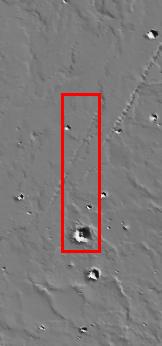
Located 1200 kilometers south of the giant shield volcano Arsia Mons, this infrared temperature image shows the flow margin of a young lava flow from Arsia that covers a much older flow. This young flow is 20 to 30 meters thick across most of its boundary edge. The large, unnamed crater at the bottom of the image is 12 kilometers across and has a depth of more than 700 meters.
Note: this THEMIS visual image has not been radiometrically nor geometrically calibrated for this preliminary release. An empirical correction has been performed to remove instrumental effects. A linear shift has been applied in the cross-track and down-track direction to approximate spacecraft and planetary motion. Fully calibrated and geometrically projected images will be released through the Planetary Data System in accordance with Project policies at a later time.
NASA's Jet Propulsion Laboratory manages the 2001 Mars Odyssey mission for NASA's Office of Space Science, Washington, D.C. The Thermal Emission Imaging System (THEMIS) was developed by Arizona State University, Tempe, in collaboration with Raytheon Santa Barbara Remote Sensing. The THEMIS investigation is led by Dr. Philip Christensen at Arizona State University. Lockheed Martin Astronautics, Denver, is the prime contractor for the Odyssey project, and developed and built the orbiter. Mission operations are conducted jointly from Lockheed Martin and from JPL, a division of the California Institute of Technology in Pasadena.
VIS instrument. Latitude -30.1, Longitude 231.9 East (128.1 West). 100 meter/pixel resolution.

